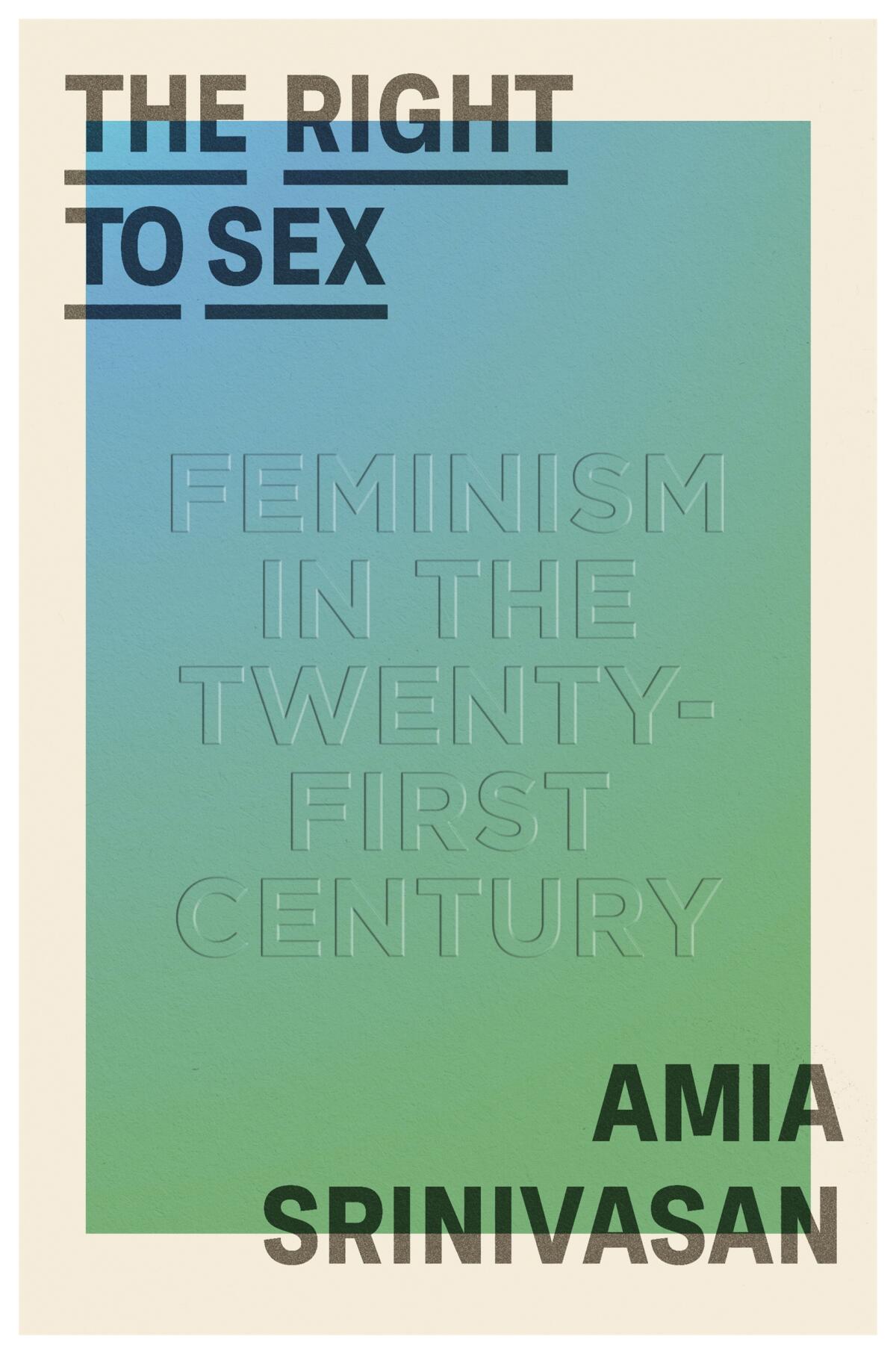Review: Is a new book feminism’s next new wave or yesterday’s backlash?

On the Shelf
The Right to Sex
By Amia Srinivasan
FSG: 304 pages, $28
If you buy books linked on our site, The Times may earn a commission from Bookshop.org, whose fees support independent bookstores.
“The Right to Sex,” a collection of essays by Amia Srinivasan, feels a bit like old news. This is not a knock on Srinivasan, a professor of social and political theory at Oxford University, but rather a reflection on how rapidly the discourse on feminism and trans rights has evolved since the author published the essay that anchors the book — “Does Anyone Have a Right to Sex?” — in the London Review of Books back in 2018.
Srinivasan pulled her title phrase from the aftermath of Elliot Rodger’s 2014 murderous rampage, after which fellow incels promoted a “misogynistic entitlement” to sex. Since then, the “right to sex” has morphed from a literal definition (through the problems of consent and the #MeToo movement) toward a philosophy of freedom.
A succinct and clear writer, Srinivasan defines her terms in helpful and revealing ways. For instance, “incel,” or “‘involuntary celibate,’ was coined by Alana, a ‘nerdy queer woman’” and blogger, in the 1990s. Not every reader may be familiar with the idea of “carceral feminism,” and Srinivasan explains it well: “a politics that looks to the coercive power of the state — police, criminal courts, prisons — to achieve gender justice.”
Another key concept for Srinivasan is intersectional Marxist feminism. She is at her strongest when demystifying it as a framework that attacks the system rather than “men” as a group. Her most provocative arguments stem from the notion that sexual politics cannot be fully examined without speaking truth on race and class. When we talk about the need to #believewomen, “Whom are we to believe,” Srinivasan asks, “the white woman who says she was raped, or the black or brown woman who insists her son is being set up?” To use the murder of Emmett Till as an example: “Carolyn Bryant or Mamie Till?”
Maggie Nelson, whose essays and poetry have changed the way we think about art, queerness and gender, talks about her timely new book, “On Freedom.”
The author complicates #MeToo’s punitive impulse by noting that “a black man serving time for sexual assault is 3.5 times more likely to be innocent than a white man” with the same conviction. And those white men (she takes comedian Louis C.K. as an example) “do not deny the truth of the allegations against them, nor even the harm they caused. What they deny is that they deserve to be punished.” That question, for Srinivasan, is directly related to race and class; it is “about the possibility that the law might treat wealthy white men as it routinely treats poor black and brown men.”
Things get murkier when Srinivasan veers into the politics of desire. In the chapter “Talking to My Students About Porn,” she writes, “sex for my students is what porn says it is” — a rather alarming statement. Porn is everywhere, but the argument that it has poisoned an entire generation, making it impossible for them to think about sex for themselves, feels too broad and poorly supported. Feminism’s attacks on porn in the ‘70s and ‘80s (via Robin Morgan, Andrea Dworkin and others) looks joyless now. Even the concept of “sex positivity” seems dated.
Some of Srinivasan’s assertions about pornography are rattlingly obtuse: “Women watch porn too; according to PornHub, 32 percent of all its users are women. (Then again, who said women can’t be misogynists?)”; “While filmed sex opens up a world of sexual possibility, all too often it shuts down the sexual imagination, making it weak, dependent, lazy, codified.” Says who?

Just as I was about to write that Srinivasan relies too heavily on heteronormative ideas, her essay, “The Sex Wars: Resolving Feminism’s Trans Conflict,” appeared in the Sept. 13 issue of the New Yorker, answering many of my questions about her reliance on the gender binary. All the strong writing Srinivasan displays in “The Right to Sex” is applied to a more current and heated debate in this piece.
“Such feminists tend to be dismissive of non-binary people,” Srinivasan writes of TERFs (trans-exclusionary radical feminists), “who, in their refusal of gender distinction, have a good claim to being the truest vanguard of gender abolition.” This inclusion of trans and nonbinary people in a discussion of feminism is what you’d expect of a book that claims to discuss feminism “in the twenty-first century.” Many of the points she makes in “The Right to Sex” also appear in this essay — and are put to better use.
What the Emmy-nominated miniseries gets wrong about feminism past and present.
In the book’s final chapter, Srinivasan returns to her strong suit, the limitations of white feminism, while addressing sex work. “The belief that a sex worker will be helped by the criminalization of her trade rests on the assumption that she has other choices available to her,” she writes. “That it is prostitution, rather than, say, poverty or immigration law, that is her fundamental problem.” Feminism fails the majority of women in the world because it is based on the demands of the privileged. While #MeToo is a good start, “for many women,” Srinivasan points out to devastating effect, “being sexually harassed is not the worst thing about their jobs.”
The #MeToo juggernaut will continue to reverberate in 21st century feminism. But the emergence of a writer like Srinivasan, who asks feminists to go further, is an enormous gift to the discourse. Her New Yorker essay expands on the evidence she presents in “The Right to Sex” in which feminists delay or complicate progress by their own infighting. Audre Lorde, in “The Cancer Journals,” wrote of feminism’s tendency to bicker over whose experience was the most important or essential to the goals of the group. Such arguments were symptomatic, Lorde writes, of the “endless ways in which we rob ourselves of each other.”
It’s obvious that Srinivasan is a thinker whose ideas can evolve, as they must. Here she is, again in the New Yorker, on the potential alliance between feminists and trans people: “It is true that a very small percentage of human beings feel sufficient distress about their bodies to need hormonal or surgical intervention. It is also true that many non-trans women know something of the heartbreak caused by a body that betrays — that weighs you down with unwanted breasts and hips; that transforms you from an agent of action into an object of male desire; that is, in some mortifying sense, not a reflection of who you really are . . . . What might a conversation between women, trans and non, look like if it started from a recognition of such continuities of experience?”
While the struggle to define “the right to sex” rages on, one thing is for certain: Amia Srinivasan has entered the chat.
Ferri’s most recent book is “Silent Cities: New York.”
More to Read
Sign up for our Book Club newsletter
Get the latest news, events and more from the Los Angeles Times Book Club, and help us get L.A. reading and talking.
You may occasionally receive promotional content from the Los Angeles Times.








